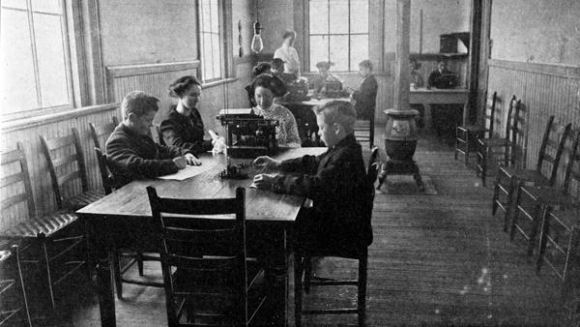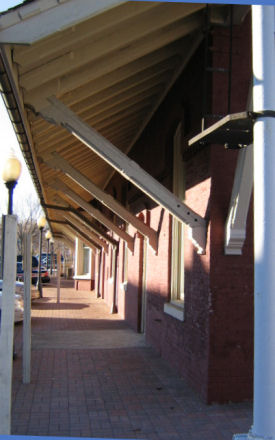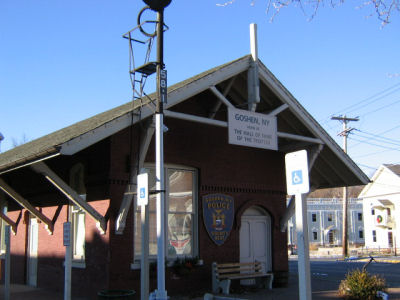
First Railroad Telegraph Received in Goshen NY--1851
Telegraphy, or the
sending of electrical impulses by wire, swept America in the mid 19th Century.
In this photo students are learning Morse Code. 
The invention of the
telegraph is generally attributed to Samuel Morse, but historians note
that even before Morse dreamed about sending signals over an electric wire
in 1832, Princeton’s Joseph Henry had successfully rung a bell from a
distance using an electrical wire and had published his findings the year
before in 1831. However, great credit must be given to Morse for spending
years and much effort petitioning the US government to back his plan for a
commercially useful telegraph system. In 1844, after an approval by
Congress, an experimental line was successfully strung from Baltimore to
Washington.  This began the task of acquiring capital to make this “miracle technology”
universally available. At the time, the average cost to string a mile was
$150—but this did not include lands rights. Land rights or “right of way”
to plant the telegraph poles would add a greatly to the cost of
infrastructure.
This began the task of acquiring capital to make this “miracle technology”
universally available. At the time, the average cost to string a mile was
$150—but this did not include lands rights. Land rights or “right of way”
to plant the telegraph poles would add a greatly to the cost of
infrastructure.
A solution to the right of
way problem appeared when the Delaware and Hudson Canal Company offered to
donate use of its right of way in Wayne and Pike Counties, PA, for use by
the telegraph lines as well. The idea of using “existing utility
corridors,” as they would be called today, was so practical that soon
nearly all telegraph lines started to follow the railroad tracks that were
crisscrossing the country at the same time. An additional benefit of
routing wires next to the tracks was efficiency of access. We often forget
the roads at the time were either nonexistent or abysmal making the siting
of wires in this way the perfect solution to fast access for repair. The New York and Lake Erie
Rail Road was one of the first railroad lines to be included in the
telegraph network, with the result that the first railroad telegraph
message in the world was sent and received in Orange County in January of
1851.
additional benefit of
routing wires next to the tracks was efficiency of access. We often forget
the roads at the time were either nonexistent or abysmal making the siting
of wires in this way the perfect solution to fast access for repair. The New York and Lake Erie
Rail Road was one of the first railroad lines to be included in the
telegraph network, with the result that the first railroad telegraph
message in the world was sent and received in Orange County in January of
1851.
An Erie Railroad supervisor used the new invention to notify the Goshen stationmaster that his arrival would be delayed because snow drifted across the tracks had stopped his train at Turner’s Station (Harriman). The Goshen Station, above, is currently headquarters for the Goshen Police.